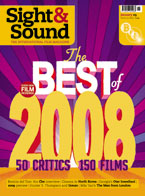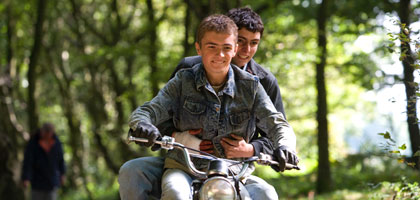
Summer
UK/Germany 2008

Reviewed by Tim Robey
Synopsis
Our synopses give away the plot in full, including surprise twists.
Derbyshire, the present. Shaun is a permanent carer for his old schoolfriend Daz, a paraplegic with weeks to live. He thinks back to the summer in the 1980s when everything changed in their lives, and to his brief relationship with Katy, who moved away to become a solicitor in Sheffield.
The teenage Shaun has acute dyslexia and is expelled from school after fracturing another boy's skull. During an exam at 16, he makes a mess of the paper, is thrown out, and crushes his own hand in a vice. Shaun and Daz break into the school premises and start a fire. When the police arrive, they give chase, and Daz is thrown off his bike, causing him to be paralysed.
In the present, Shaun tracks down Katy to inform her of Daz's worsening condition. Daz dies. Shaun tells Daz's teenage son Daniel, who reacts angrily. The three of them revisit the lake where Shaun, Katy and Daz spent the summer.
Review
The beckoning pull of memory shapes Kenny Glenaan's third feature, after the made-for-TV Gas Attack (2001) and the Simon Beaufoy-scripted Yasmin (2004). When the past intrudes, it's first announced by a shaft of sunlight flooding the bedroom where Robert Carlyle's haunted bachelor Shaun is taking a breather from his duties as carer for his paraplegic friend Daz. Earlier, lying outdoors in the film's opening scene, he shields his eyes from the sun overhead, as if suppressing a recollection that still casts a shadow over him. He rises to approach his childhood self running through a meadow, but can only look on through a pane of invisible glass, pressing his nose up against it in a state of reverie that's both tactile and strangely quarantined. This barrier is later breached from the other side: Shaun's teenage girlfriend Katy steps through it, rising from a lake in her swimming costume and passing across in an unbroken shot to kiss the adult Shaun as he lies in bed.
Glenaan's thoughtful approach to structuring his story is also marked by a considered use of sound to imply further slippage between the two timeframes. Shaun and Daz's shrieks as they cycle down a gravel quarry continue into the next image, of the adult Shaun and others sitting quietly in a remedial computer class. In a generally well-assembled, well-acted piece of work, the single strongest creative element may be Stephen McKeon's score: this low murmur, working in concert with the flashbacks, rises to a subdued, keening note that seems to want an answering call. If one is supplied, it's in Carlyle's robustly interiorised performance, a Kristin Scott Thomas-style slow burn around which the film builds itself.
The script is less sophisticated than its execution. The flashbacks are aiming for a sort of archaeology of trauma, explaining Daz's paralysis, Shaun's immobile left hand and the disappearance of Katy from their lives, while simultaneously making the usual case for this being an enchanted summer that ended all their childhoods and after which Nothing Would Ever Be The Same. It's a lot to load on one already over-exploited season, as even Stephen King might agree by now. Sometimes Glenaan and screenwriter Hugh Ellis push the 'sensitive' button too hard in their diagnosis of male problems - for example when the young Shaun sits outside the headmaster's office and overhears his mother being told that he has a below-average IQ and must be expelled for fracturing a classmate's skull. There might have been subtler ways, too, to hint at the generational transfer of working-class anger than expressly referring to Daz's wayward son as "a chip off t' old block".
More often, though, Glenaan finds acute visual means to dramatise Shaun and Daz's predicaments. When we see the young Shaun struggling through an English test, his fist clenched fiercely around the pencil that won't let him write, it's a strong and unsettling image of dyslexic frustration. The ame problem causes him to be thrown out of an exam at 16, and he exchanges a resentful scowl with his younger self in the corridor, a mutual acknowledgement of being dealt some shoddy genes. Caring for the now paralysed Daz in later life, Shaun rarely gets the whole frame to himself in their poky household - it's no surprise that cinematographer Tony Slater-Ling is a veteran of cramped quarters and full-tilt domestic squabbles in Shameless.
The film's main virtue is economy - there's hardly a wasted shot - wedded with the patience that defers details of Shaun's employment at a garage snack-stop for a good hour, on the basis that Daz is his real occupation. By contrast the rather sketchily written Katy is the character now defined by her work as a solicitor. In the flashbacks, we're spared too many showy Son of Rambow-style 1980s signifiers save for an amusing shot of the 16-year-old Daz attempting a moonwalk. If this prompts a vague awareness that Carlyle and Steve Evets (as Daz) are slightly too old for their roles, it's something you hardly notice because of Glenaan's sound directorial instincts and beautiful casting - when we see young Shaun in a profile shot next to his mum (Red Road's Kate Dickie), for instance, they're so believably mother and son that minor plausibility problems melt away.
Credits
- Director
- Kenny Glenaan
- Producer
- Camilla Bray
- Screenplay
- Hugh Ellis
- Cinematographer
- Tony Slater-Ling
- Editor
- Kristina Heatherington
- Production Designer
- Jane Levick
- Composer/Guitars
- Stephen McKeon
